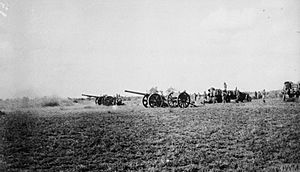Battle of Salaita Hill facts for kids
Quick facts for kids Battle of Salaita |
|||||||
|---|---|---|---|---|---|---|---|
| Part of the East African campaign | |||||||
 British 4-inch naval guns on improvised carriages in position above Njoro Drift during the two day bombardment of German positions at Salaita, 8 March 1916. |
|||||||
|
|||||||
| Belligerents | |||||||
|
|
||||||
| Commanders and leaders | |||||||
| Strength | |||||||
| 2,300 | 6,000 41 machine guns 18 field guns |
||||||
| Casualties and losses | |||||||
| unknown (but light) | 172 killed, wounded or missing | ||||||
The Battle of Salaita Hill was a big fight during World War I in East Africa. It was the first major battle where British, Indian, Rhodesian, and South African soldiers fought together. This battle happened on February 12, 1916. It was part of a larger plan by General Jan Smuts to attack German East Africa.
Contents
Why Salaita Hill Was Important
Salaita was a key spot near the border town of Taveta in what is now Kenya. It was a good place to watch for enemies. The Allies thought it was only guarded by about 300 German soldiers with no big guns. This made Salaita an attractive first target for General Smuts' attack.
The plan to move into German East Africa was led by the 2nd South African Division. Their commander was Brigadier General Wilfrid Malleson. He didn't have much experience leading troops in battle. Before the war, he worked for British Field Marshal Kitchener.
The Forces Involved
Brigadier General Beves' 2nd South African Infantry Brigade and the First East African Brigade were chosen to attack Salaita. With an Indian artillery group, their total force was about 6,000 men.
However, the British information was wrong. Salaita was actually strongly defended by about 1,300 German soldiers. These troops were led by Major Georg Kraut. Also, unknown to the Allies, there were six more German Schutztruppe companies nearby. These added about 1,000 more soldiers.
The Battle Begins
The Allied attack started on the morning of February 12. First, they fired big 4-inch guns at the German positions. These guns had been taken from a sunken ship called HMS Pegasus.
But there was a problem with the plan. The guns fired at the wrong place. They aimed at the German trenches at the top of Salaita Hill. The real front line was further down the hill. This warning shot told the Germans an attack was coming. It didn't stop them from getting ready.
Two hours into the attack, Malleson's soldiers were about 2,000 meters (6,500 feet) from Salaita. Then, German artillery started firing back.
The Fight on the Hill
Beves sent his brigade forward. The 7th South African Infantry Regiment led the charge. The 5th and 6th Regiments protected the sides. The soldiers spread out in a loose formation.
The South African regiments managed to break through the first German line. But they were stopped by heavy machine gun fire. They had many soldiers hurt and were forced to pull back. As they retreated, a German relief group attacked them from the side. This group was led by Captain Schultz from nearby Taveta.
After this fight, the Allied force moved further north to Serengeti. They had 172 soldiers killed, wounded, or missing. Most of these, 138, were South African.
What Happened Next
After the battle, there was some tension between the 6th South African Infantry Regiment and the 130th Baluchis (Indian soldiers). The South African unit didn't want to fight alongside their Indian allies.
When the South Africans had to retreat from the German askaris (African soldiers fighting for Germany), the Baluchis held their ground. Later, the Baluchis found a machine gun that the South African soldiers had left behind. They sent it back with a note. The note politely asked the South Africans to stop using disrespectful names for their people.
Because of this battle, General Paul von Lettow-Vorbeck, who commanded the German forces in East Africa, sent more troops to the Kilimanjaro area. Nearly half of his forces were moved there. This included 800 German soldiers and 5,200 askaris.

